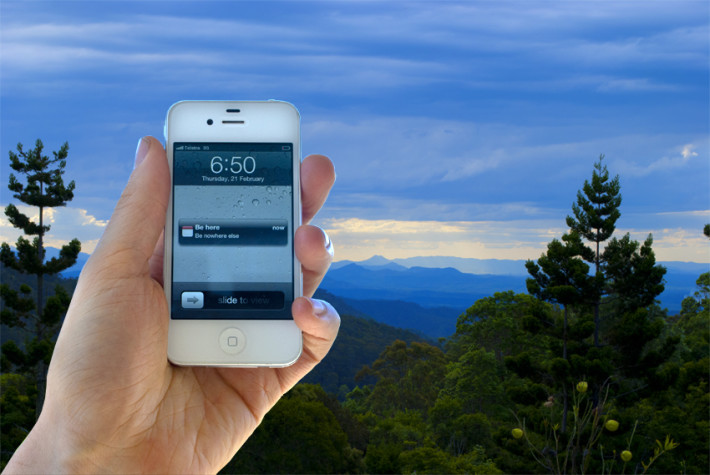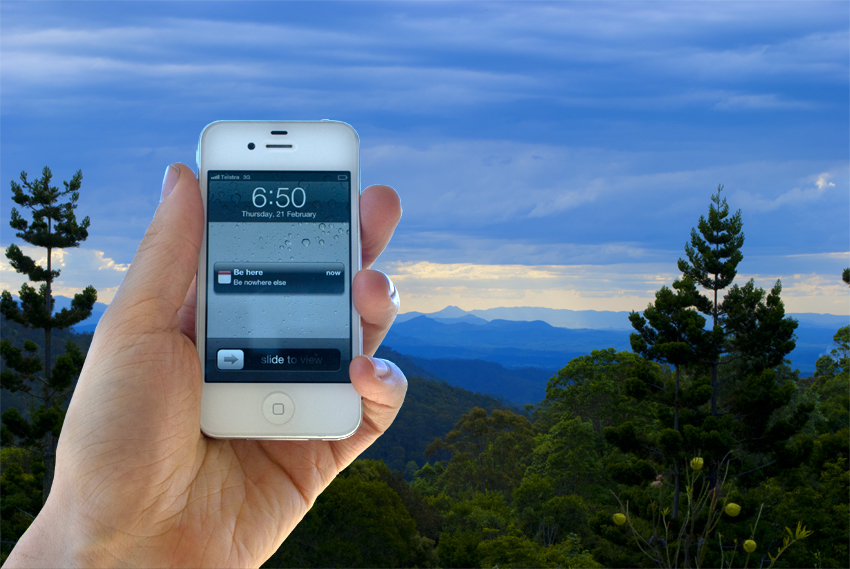Fierce conversations principle 3: Be here and nowhere else (smartphones versus one-to-ones)

My review of Scott’s third principle of fierce conversations comes at a time when I am increasingly conscious of the technology distractions around me. While these distractions act as barriers to being “here” in the moment, there are other habits that can prevent authentic and intentional conversations with those around us.
The smartphone barrier to being “here”
Many of us stare at a screen in front of us as much as we look at other people in our “always on” age of technology. Business meetings and dinner parties are subtly illuminated by the soft glow of smart phones and tablets reflecting off faces making furtive glances to their devices. Boardroom conversations share priorities with Facebook, news sites, games and emails. People stare at their phone as they walk down the sidewalk, developing a heightened sixth sense of the world just outside of their peripheral vision.
Over half the population in the US and Europe have smartphones and the number is increasing across most countries. I acknowledge I may be projecting my own propensity for frequent checking emails and social channels, but I know I am not alone in both habit and concern. For example, the Lookup Project aims to get people to look up from their devices and experience the world around them, although with only 400 followers perhaps people are too busy on their phones to join. A LinkedIn article urged people to go 21 days without bringing out a phone in the company of others.
Smartphones have legitimized a state of perpetual distraction and prevent us from being fully “here”. This relates to principle three of Susan Scott’s book Fierce Conversations and its commission to “Be here, prepared to be nowhere else”.
Scott highlights that when we are with others, every conversation has to count, as our conversations are the relationship. A fierce conversation commissions us to come into the conversation with empty hands, bringing nothing but ourselves. I see empty hands to include keeping our smartphone in our pocket.
The one-to-one conversation
A means to practice this notion of being “here” is to have what Scott refers to as “one-to-ones”. These conversations are characterized by:
- a fierce affection for the person;
- a genuine curiosity about the topic of the moment;
- an insatiable appetite for learning; and
- a fierce resolve to be with the individual and nowhere else.
This premise can be applied to personal as well as work relationships. As an example applied to the working relationship, questions that can frame a one-on-one include:
- What has become clear since last we met?
- What is the one area that, if you made an improvement, would give you and others the greatest return on time, energy, and dollars invested?
- What is currently impossible to do that, if it were possible, would change everything?
- What are you trying to make happen in the next three months?
- What is the most important decision you are facing? What’s keeping you form making it?
- What topic are you hoping I won’t bring up?
- What are under your responsibility are you most satisfied with? Least satisfied with?
- What part of your responsibilities are you avoiding right now?
- What are your strongest employees? What are you doing to ensure they are happy and motivated?
- Who are your weakest employees? What is your plan for them?
- What conversations are you avoiding right now?
- What do you wish you had more time to do?
- What things are you doing that you would like to stop doing or delegate to someone else?
- If you were hired to consult with our organisation, what would you advise?
- If you were competing against our organisation, what would you do?
- What threatens your peace? What threatens the organisation? Your health? Your personal fulfillment?
These questions are confronting, getting past “how are you?” and into the important aspects of the person. There are few who would not consider the one-on-one to be a good idea. Unfortunately, the smartphone is not the only habit preventing full engagement in these fierce conversations.
Smartphones not the only barrier to one-to-ones
Authentic conversations like those described above are not necessarily happening in our relationships, organisation, or wider community. This may be as a result of three alternatives:
- Too much “nice”
We can suffer from too much “nice”. We can be so concerned with maintaining status quo and minimizing conflict that we never get down to doing business. - Grazing
We can substitute real engagement with five-minute catch-ups. Shallow time can result in shallow conversations and shallow relationships. A year of kitchen chats is no substitute for intentional conversations. - Directives
The one-to-one conversation is two-way, typically initiated by one person with a focus on the other person. If the only time you connect with subordinates is to tell them what to do, then there is likely a disconnect in the relationship.
Even as I highlight these points, I am reminded by a sentiment Scott points out:
“All conversations we have are with ourselves, and sometimes they involve others.”
With this in mind, perhaps a first step is to have a one-to-one with ourselves. To what extent are we too nice with ourselves, not confronting ourselves with hard reality? Do we ever sit down and address the real issues, or do we “graze” on self-help snippets and good intentions? When we do look to our personal development, is it with critical berating judgment or do we have an open one-to-one and allow ourselves the same grace we might allow to others?
All worthy questions we can ask ourselves… as soon as we put away our phones.


Time to make like Don Draper and leave your hat and your phone on the stand on the way into the meeting: http://techcrunch.com/2012/12/09/digital-hat-racks/
I like it… I was going to say you can’t surf the web from your hat, but it is only a matter of time… http://www.gizmag.com/led-hat-fashion-technology/25474/